Fattorini H.O., Kerber A. The Cauchy Problem
Подождите немного. Документ загружается.

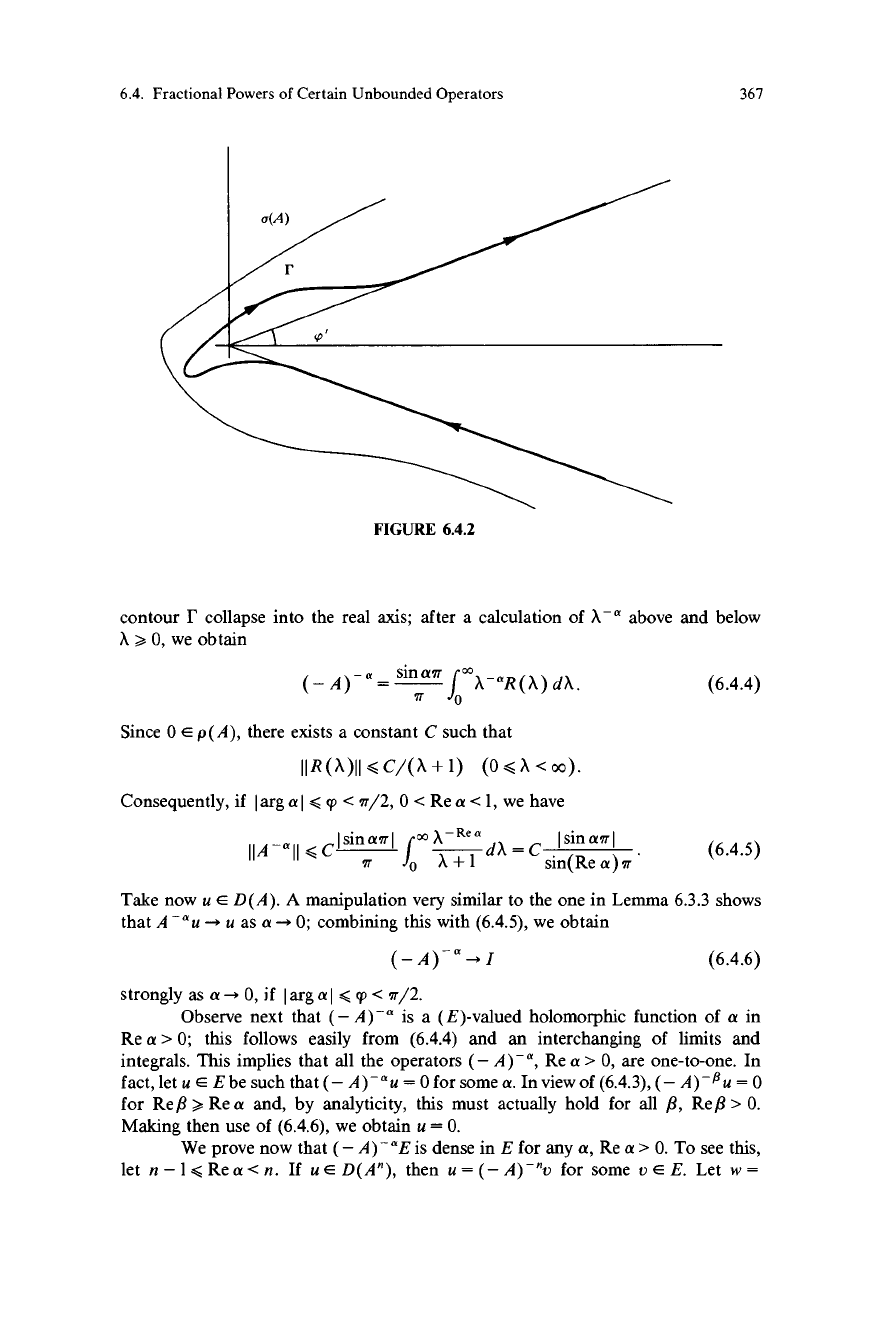
6.4. Fractional Powers of Certain Unbounded Operators
367
FIGURE 6.4.2
contour 1' collapse into the real axis; after a calculation of A-" above and below
A > 0, we obtain
"_ sina7r
A "R
d
X
- 4
6 4 4
( )
.
)
IT
Jp
(
( . . )
Since 0 E p (A), there exists a constant C such that
IIR(X)II<C/(A+l) (0<A<oo).
Consequently, if
I arg a I < q < 9T/2, 0 < Re a < 1, we have
Isina7rI
00 A-Re°
_ IsinaITI
IIA II<C
4
(6 5)
IT
I
X+I
sin(Rea)IT
.
.
Take now u E D(A). A manipulation very similar to the one in Lemma 6.3.3 shows
that A -"u - u as a - 0; combining this with (6.4.5), we obtain
(-A)-"->I (6.4.6)
strongly as a- 0, if I arg a < q< IT/2.
Observe next that (- A)-' is a (E)-valued holomorphic function of a in
Re a > 0; this follows easily from (6.4.4) and an interchanging of limits and
integrals. This implies that all the operators (- A)-', Re a > 0, are one-to-one. In
fact, let u E Ebe such that (- A)-"u = 0 for some a. In view of (6.4.3), (- A)-Pu = 0
for Re$ > Re a and, by analyticity, this must actually hold for all fl, Re$ > 0.
Making then use of (6.4.6), we obtain u = 0.
We prove now that (- A)-"E is dense in E for any a, Re a > 0. To see this,
let n-1<Rea<n. If uED(A"), then u=(-A)-"v for some vEE. Let w =
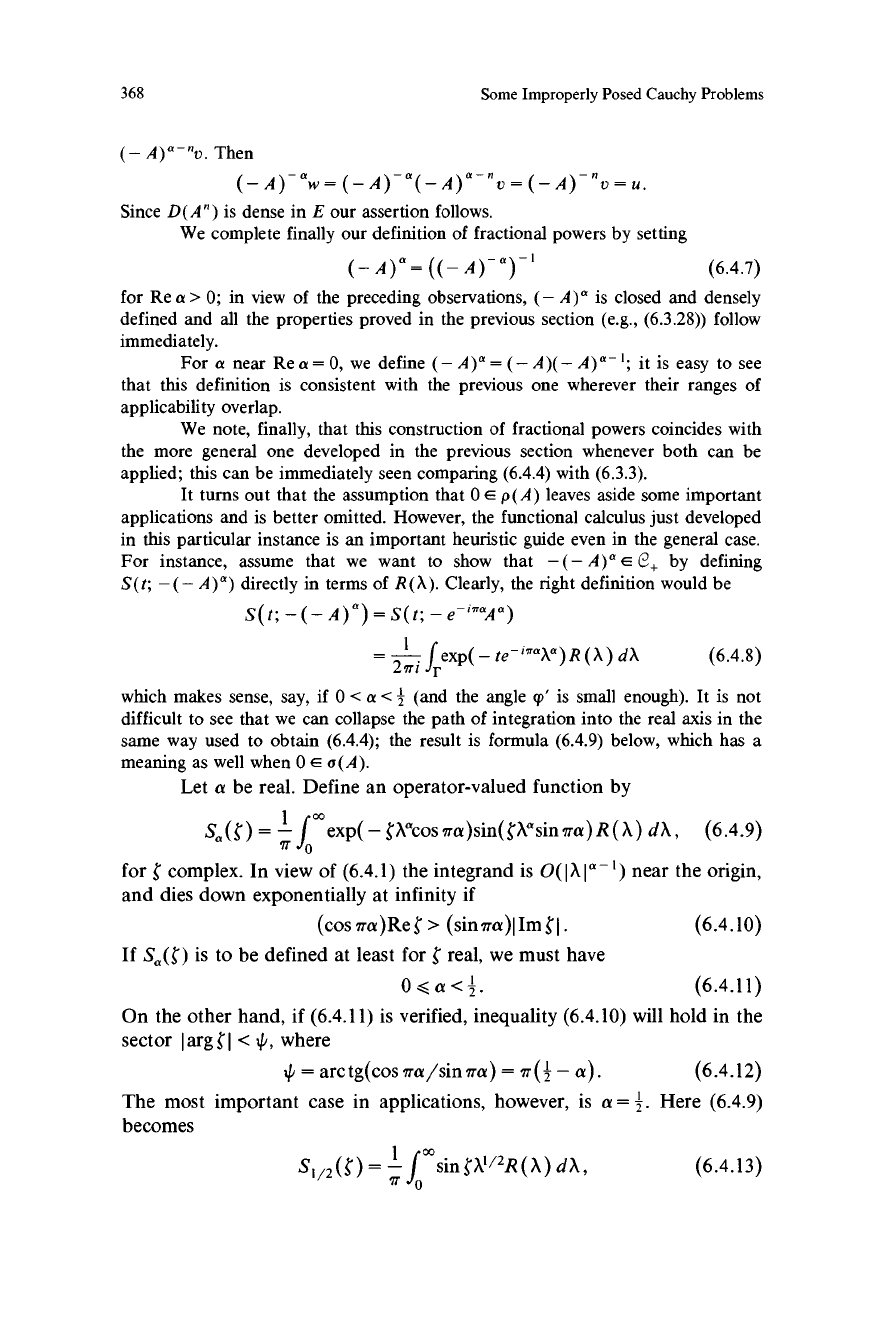
368
Some Improperly Posed Cauchy Problems
(- A)'-"v. Then
(-A)-aw=(-A)-a(-A)a-"v=(-A) "v=u.
Since D(A") is dense in E our assertion follows.
We complete finally our definition of fractional powers by setting
(-A)a=((-A)-a)-'
(6.4.7)
for Re a > 0; in view of the preceding observations, (- A)' is closed and densely
defined and all the properties proved in the previous section (e.g., (6.3.28)) follow
immediately.
For a near Re a = 0, we define (- A)" _ (- A)(- A)"- 1; it is easy to see
that this definition is consistent with the previous one wherever their ranges of
applicability overlap.
We note, finally, that this construction of fractional powers coincides with
the more general one developed in the previous section whenever both can be
applied; this can be immediately seen comparing (6.4.4) with (6.3.3).
It turns out that the assumption that 0 e p(A) leaves aside some important
applications and is better omitted. However, the functional calculus just developed
in this particular instance is an important heuristic guide even in the general case.
For instance, assume that we want to show that - (- A)' e C2+ by defining
S(t; - (- A)') directly in terms of R (X). Clearly, the right definition would be
S(t; -(- A)a) =S(t; - e-ImaAa)
1
f exp(-te-"'aV)R(X)dX
27ri r
(6.4.8)
which makes sense, say, if 0 < a < i (and the angle q)' is small enough). It is not
difficult to see that we can collapse the path of integration into the real axis in the
same way used to obtain (6.4.4); the result is formula (6.4.9) below, which has a
meaning as well when 0 E a(A).
Let a be real. Define an operator-valued function by
Sam= f
sinira)R(X)dX,
(6.4.9)
77
0
for
complex. In view of (6.4.1) the integrand is O(I X I"
') near the origin,
and dies down exponentially at infinity if
(cosira)Re > (sin
(6.4.10)
If is to be defined at least for real, we must have
0 <a< z.
(6.4.11)
On the other hand, if (6.4.11) is verified, inequality (6.4.10) will hold in the
sector
I arg
I < ,/i, where
= arctg(coslra/sin7ra) = ir('-z - a).
(6.4.12)
The most important case in applications, however, is a = z . Here (6.4.9)
becomes
1 c
S112(fl f sin2t'/2R(X) dA,
(6.4.13)
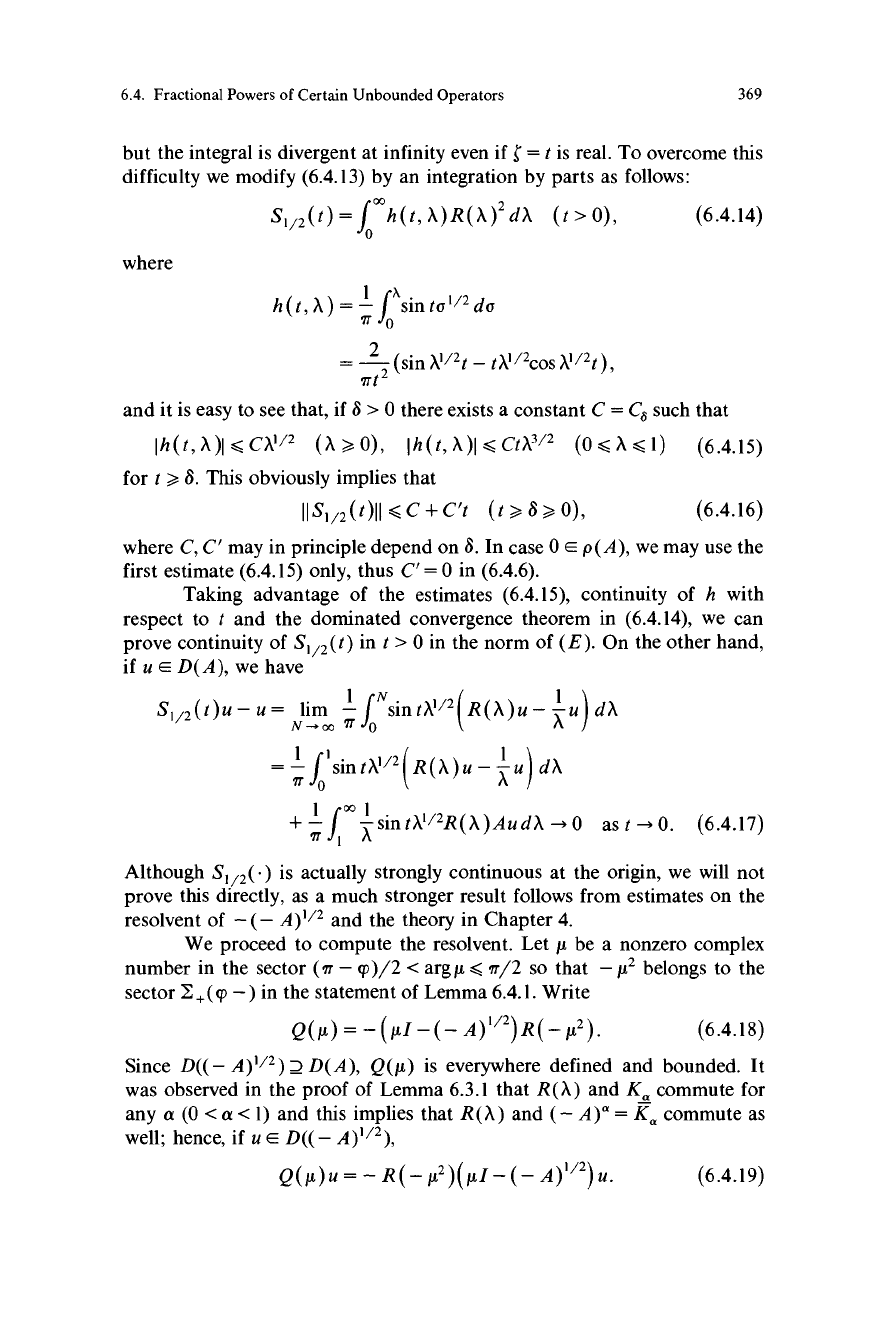
6.4. Fractional Powers of Certain Unbounded Operators
369
but the integral is divergent at infinity even if = t is real. To overcome this
difficulty we modify (6.4.13) by an integration by parts as follows:
Sl/2(t)= f'h(t,X)R(A)2dX (t>0), (6.4.14)
0
where
h(t, X) = 1 f'sinta'/2do
77
o
= 22 (sin V/2t
- t; /2cos X'/2t),
Irt
and it is easy to see that, if S > 0 there exists a constant C = Cs such that
Ih(t,X)I
(X
0), Ih(t,X)I < CtXI/2 (0<
<1)
(6.4.15)
for t , S. This obviously implies that
IISI/2(t)II,c+c1t (t,s,0),
(6.4.16)
where C, C' may in principle depend on S. In case 0 E p (A), we may use the
first estimate (6.4.15) only, thus C' = 0 in (6.4.6).
Taking advantage of the estimates (6.4.15), continuity of h with
respect to t and the dominated convergence theorem in (6.4.14), we can
prove continuity of SI/2(t) in t > 0 in the norm of (E). On the other hand,
if u E D(A), we have
Sl/2(t)u-u=limo ! fNsintA'/2(R(X)u-Xu)dX
0
_
f'sin s;'/2(R(x)u- -1u) dX
0
+ - fi k sintX'/2R(X)AudX->0
ast-*0. (6.4.17)
Although is actually strongly continuous at the origin, we will not
prove this directly, as a much stronger result follows from estimates on the
resolvent of - (- A)'/2 and the theory in Chapter 4.
We proceed to compute the resolvent. Let µ be a nonzero complex
number in the sector (77 - 9))/2 < arg t 5 7r/2 so that - µ2 belongs to the
sector 2+(y -) in the statement of Lemma 6.4.1. Write
Q(µ)=-(µI-(-A)1/2)R(-µ2).
(6.4.18)
Since D((- A)'/2) 2 D(A), Q(µ) is everywhere defined and bounded. It
was observed in the proof of Lemma 6.3.1 that R(X) and K. commute for
any a (0 < a < 1) and this implies that R(X) and (- A)' = K, commute as
well; hence, if u E D((- A)t/2),
Q(µ)u=-R(-µ2)(µI-(-A)1/2)u.
(6.4.19)

370
Some Improperly Posed Cauchy Problems
FIGURE 6.4.3
Let now u E D(((- A)'/2)2). In view of the preceding observations,
R(- µ2)u E D(((- A)'/2)2) and
(µI+(-A)112)Q(µ)u= (-µ2I-A)R(-µ2)u=u
(6.4.20)
since ((- A)'/2)2 c - A (see (6.3.14)). On the other hand, D(((- A)'/2)2) Q
D(A2) is dense in E; this and the facts that Q(µ) is bounded and (- A)'/2
closed imply that Q(µ)E C D((- A)'/2) and
(µI +(- A)'12)Q(µ) = I
(6.4.21)
so that µI + (- A)'/2 is onto. Assume there exists u E D((- A)'/2) such that
(µI -(- A)'/2)u = 0; we obtain from (6.4.19) that Q(µ)u = 0, and then
from (6.4.21) that u = 0, thus proving that µI -(- A)'/2 is one-to-one.
We can repeat the entire argument replacing µ by - µ, obtaining
similar results for µI - ( - A)'/2 and µI + (- A)'/2. It follows in particular
that µI + (- A)'/2 is invertible, and, in view of (6.4.21),
Q(µ) _ (µI+(-
A)'/2)-'
= R(µ; -(- A)' 2).
We try now to find a different formula for R (µ; - ( - A )1/2). Making use of
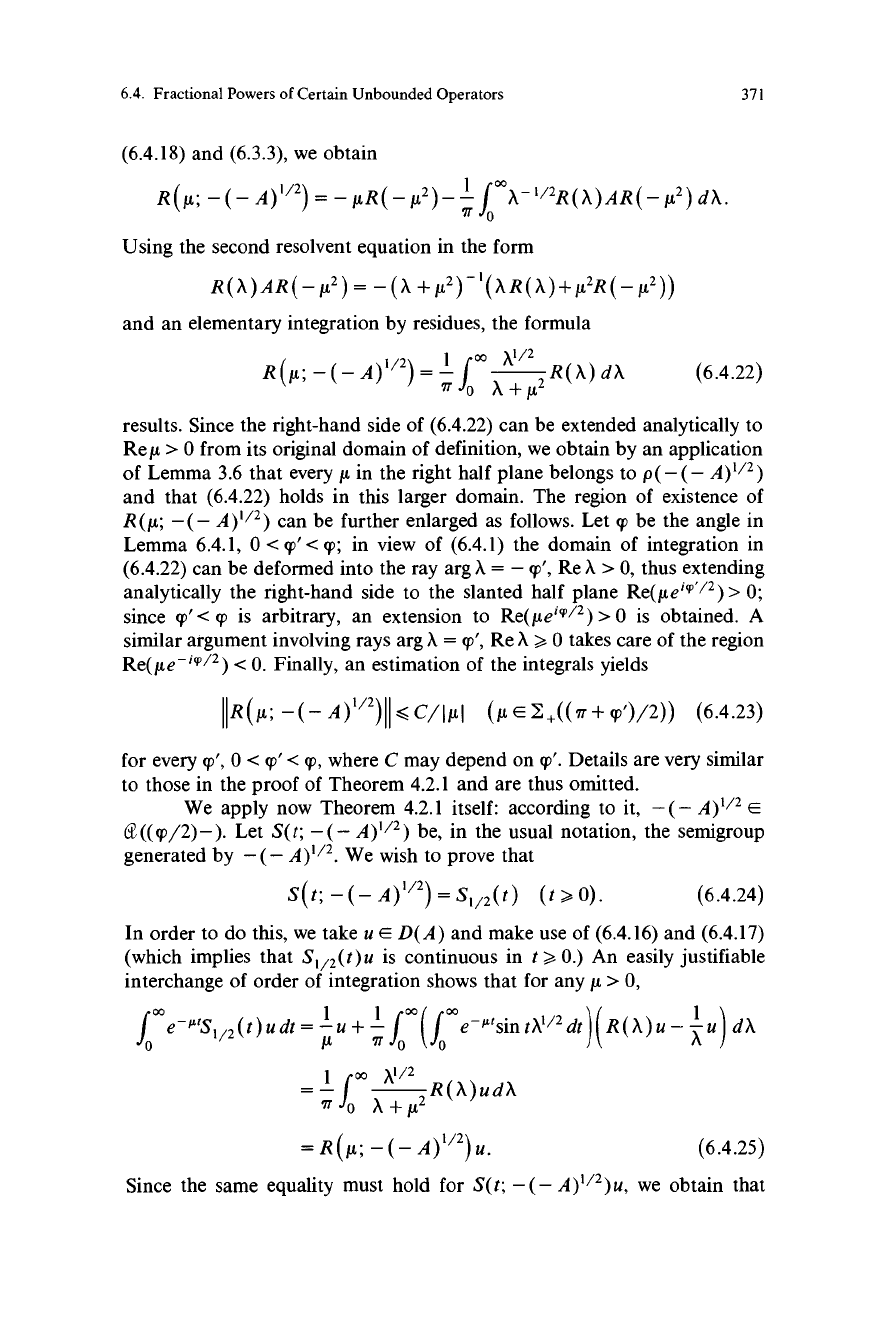
6.4. Fractional Powers of Certain Unbounded Operators
371
(6.4.18) and (6.3.3), we obtain
R(µ;-(-A)"2)=-µR(-µ2)- 1
X-1/2R(X)AR(-µ2)dX.
0
Using the second resolvent equation in the form
R(X)AR(-µ2) = -(x+µ2)-'(XR(X)+µ2R(-µ2))
and an elementary integration by residues, the formula
00
1/2
R(µ; -(-A)'/2)= _ f
+µ2R(X)dA (6.4.22)
results. Since the right-hand side of (6.4.22) can be extended analytically to
Re a > 0 from its original domain of definition, we obtain by an application
of Lemma 3.6 that every µ in the right half plane belongs to p ( - ( - A )1/2)
and that (6.4.22) holds in this larger domain. The region of existence of
R(µ; -(- A)'/2) can be further enlarged as follows. Let T be the angle in
Lemma 6.4.1, 0 < T' < q,; in view of (6.4.1) the domain of integration in
(6.4.22) can be deformed into the ray arg A = - T', Re A > 0, thus extending
analytically the right-hand side to the slanted half plane Re(µe','/2) > 0;
since q)'< q2 is arbitrary, an extension to Re(µe" /2) > 0 is obtained. A
similar argument involving rays arg A = (p', Re A >, 0 takes care of the region
Re(µe-'q'/2) < 0. Finally, an estimation of the integrals yields
JR(µ'-(-A)'/2)JJ'<C/lµl
(µE2+((IT+92')/2))
(6.4.23)
for every q2', 0 < q2'< q2, where C may depend on q2'. Details are very similar
to those in the proof of Theorem 4.2.1 and are thus omitted.
We apply now Theorem 4.2.1 itself: according to it, - (-A )1/2 E
l (((p/2) - ). Let S(t; - (- A)1/2 ) be, in the usual notation, the semigroup
generated by - (- A )1/2. We wish to prove that
S(t; -(-A)1/2)=S,/2(t) (t>1 0). (6.4.24)
In order to do this, we take u E D(A) and make use of (6.4.16) and (6.4.17)
(which implies that S,/2(t)u is continuous in t > 0.) An easily justifiable
interchange of order of integration shows that for any µ > 0,
f oe-'"S,/2(t)udt=lu+
I
r f
oo
e-AtsintA'/2dt II R(X)u- 1 u) dX
o
µ
o o /`
R(A)udX
77
o A+µ2
U.
= R
(µ; _ (_ A )
1/2)
(6.4.25)
Since the same equality must hold for S(t; -(- A)'/2)u, we obtain that
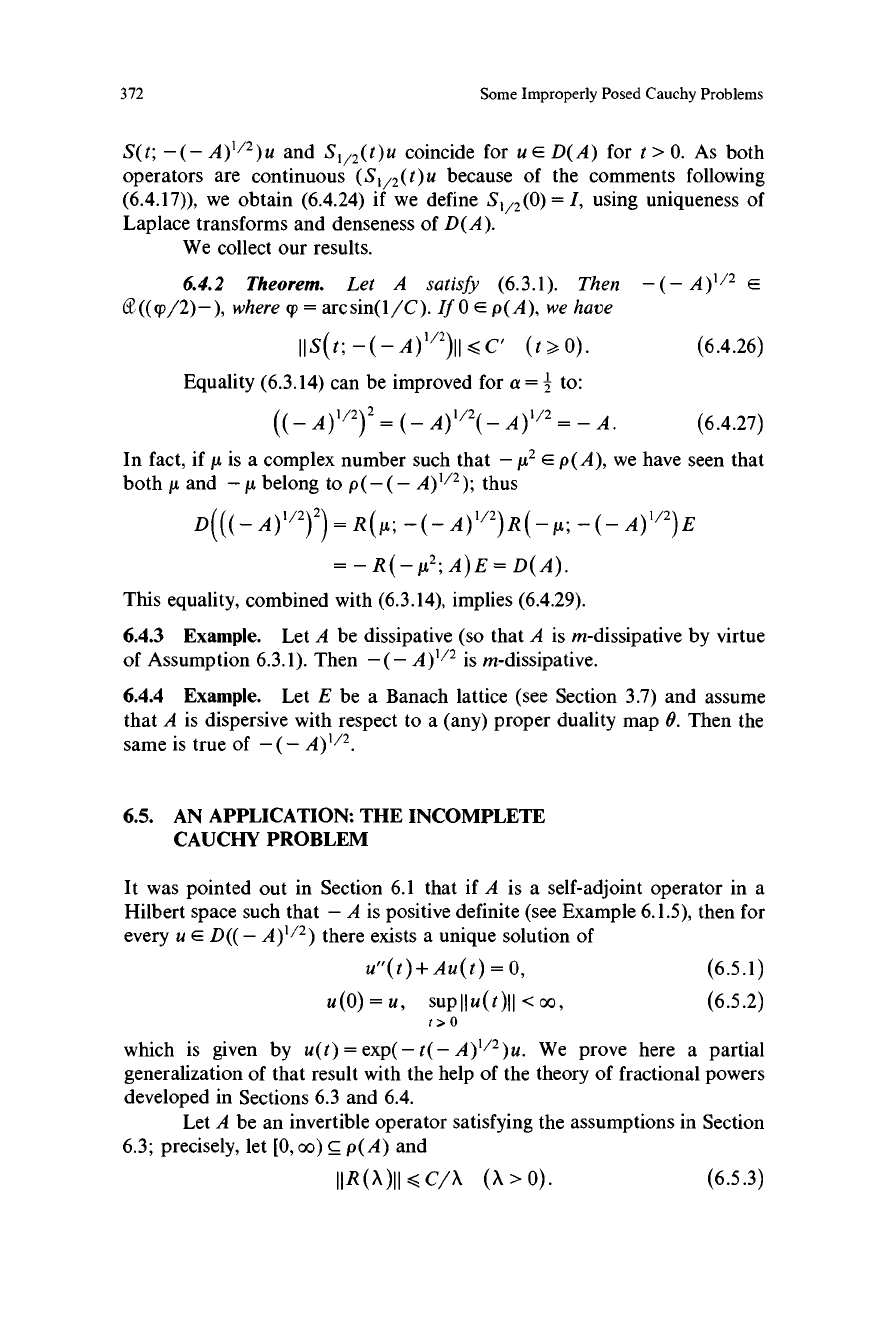
372 Some Improperly Posed Cauchy Problems
S(t; -(- A)'/2)u and S,/2(t)u coincide for u E D(A) for t > 0. As both
operators are continuous (S,12(t)u because of the comments following
(6.4.17)), we obtain (6.4.24) if we define S,/2(0) = I, using uniqueness of
Laplace transforms and denseness of D(A).
We collect our results.
6.4.2 Theorem.
Let A
satisfy (6.3.1).
Then -(-A )1/2 E
(((V/2)-), where (p = aresin(l/C). If 0 E p(A), we have
(t>0).
(6.4.26)
Equality (6.3.14) can be improved for a = z to:
((- A)'/2)2
= (-
A)I/2(- A)'/2 = - A.
(6.4.27)
In fact, if µ is a complex number such that - µ2 E p(A), we have seen that
both µ and -µ belong to p(-(- A)'/2); thus
D(((- A)l/2)2)
=
R(µ; -(- A)1/2)R(-µ; -(- A)'/2)E
=-R(- L2;A)E=D(A).
This equality, combined with (6.3.14), implies (6.4.29).
6.4.3
Example.
Let A be dissipative (so that A is m-dissipative by virtue
of Assumption 6.3.1). Then -(- A)'/2 is m-dissipative.
6.4.4 Example.
Let E be a Banach lattice (see Section 3.7) and assume
that A is dispersive with respect to a (any) proper duality map 0. Then the
same is true of - (- A)'/2.
6.5. AN APPLICATION: THE INCOMPLETE
CAUCHY PROBLEM
It was pointed out in Section 6.1 that if A is a self-adjoint operator in a
Hilbert space such that - A is positive definite (see Example 6.1.5), then for
every u E D((- A
)1/2) there exists a unique solution of
u"(t)+Au(t)=0, (6.5.1)
u(0)=u, supllu(t)II<oo, (6.5.2)
t>0
which is given by u(t) = exp(- t(- A)'/2)u. We prove here a partial
generalization of that result with the help of the theory of fractional powers
developed in Sections 6.3 and 6.4.
Let A be an invertible operator satisfying the assumptions in Section
6.3; precisely, let [0, oo) c p(A) and
IIR(X)II <C/A (A>0). (6.5.3)
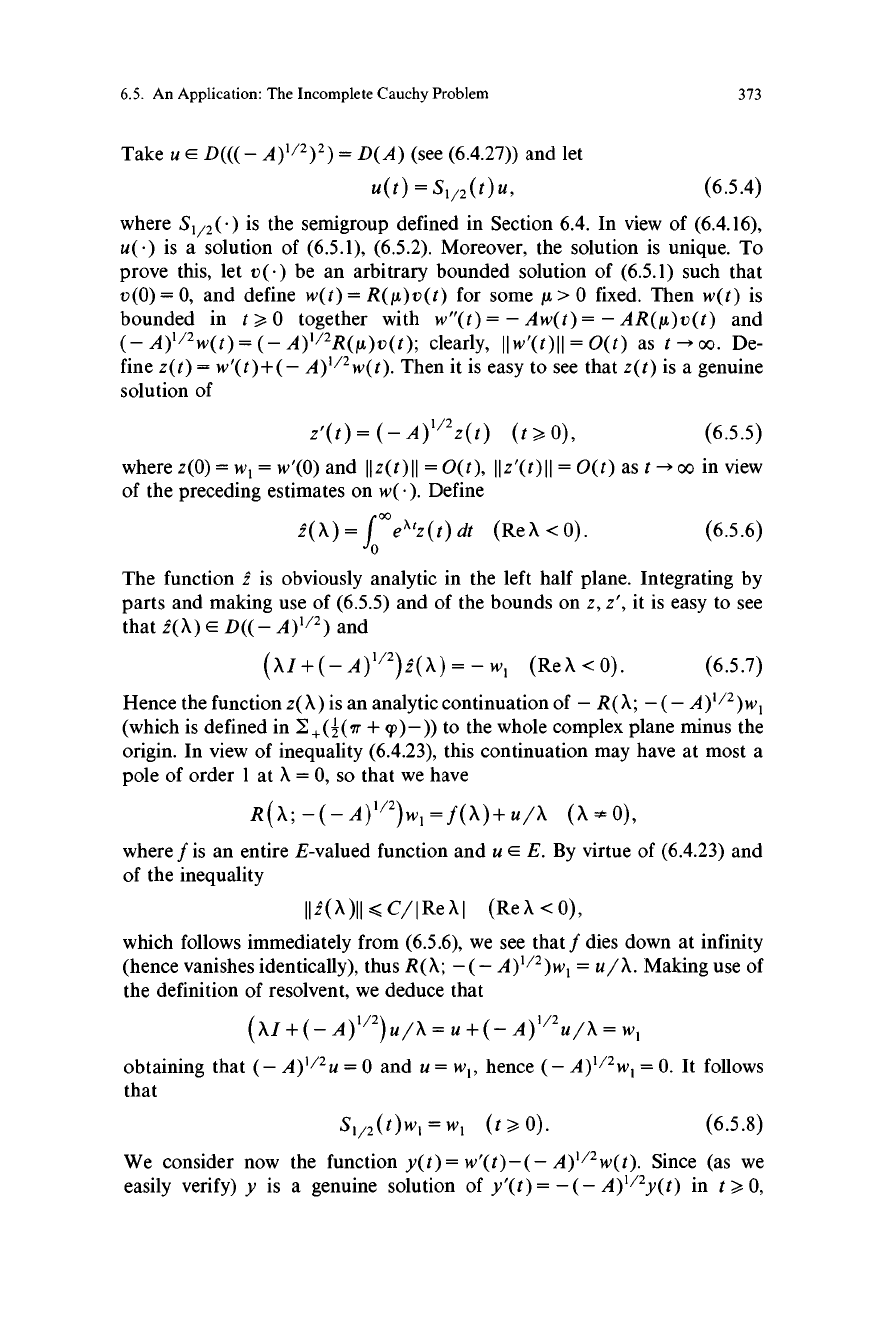
6.5. An Application: The Incomplete Cauchy Problem
373
Take u E D(((- A)'/2)2) = D(A) (see (6.4.27)) and let
u(t) = S,/2(t)u, (6.5.4)
where
is the semigroup defined in Section 6.4. In view of (6.4.16),
is a solution of (6.5.1), (6.5.2). Moreover, the solution is unique. To
prove this, let v(-) be an arbitrary bounded solution of (6.5.1) such that
v(0) = 0, and define w(t) = R(tt)v(t) for some p > 0 fixed. Then w(t) is
bounded in
t >, 0 together with w"(t) = - Aw(t) = - AR(IL)v(t) and
(-A )'/2w(t) = (- A)'/2R(t)v(t); clearly, IIw'(t)II = 0(t) as t - oo. De-
fine z(t) = w'(t)+(- A)'/2W(t). Then it is easy to see that z(t) is a genuine
solution of
z'(t) _ (- A)'/2Z(t) (t > 0), (6.5.5)
where z(0) = w, = w'(0) and 11z(t)II = O(t), Ilz'(t)II = O(t) as t -* oo in view
of the preceding estimates on w(.). Define
i(A) = f*extz(t) dt
(ReA <0).
(6.5.6)
e
The function i is obviously analytic in the left half plane. Integrating by
parts and making use of (6.5.5) and of the bounds on z, z', it is easy to see
that i(A) E D((- A)'/2) and
(XI+(-A)'/2)2(A)=-w, (ReA<0).
(6.5.7)
Hence the function z(A) is an analytic continuation of - R (X; - (- A )' /2 ) w
(which is defined in 2 +(z (7r + (p)-)) to the whole complex plane minus the
origin. In view of inequality (6.4.23), this continuation may have at most a
pole of order 1 at A = 0, so that we have
R(A;-(-A)1/2)w,=f(A)+u/A (A.0),
where f is an entire E-valued function and u E E. By virtue of (6.4.23) and
of the inequality
Ilz(A)II <C/IReAI
(ReA <0),
which follows immediately from (6.5.6), we see that f dies down at infinity
(hence vanishes identically), thus R(A; -(- A)'/2)w, = u/A. Making use of
the definition of resolvent, we deduce that
(XI+(-Al/2)u/A=u+(-A)'/2U/A=w1
obtaining that (- A)'/2u = 0 and u = w1, hence (- A)'/2w1 = 0. It follows
that
SI/2(t)w1= w,
(t.0).
(6.5.8)
We consider now the function y(t)= w'(t)-(- A)'/2w(t). Since (as we
easily verify) y is a genuine solution of y'(t) _ -(- A)'/2y(t) in t >, 0,
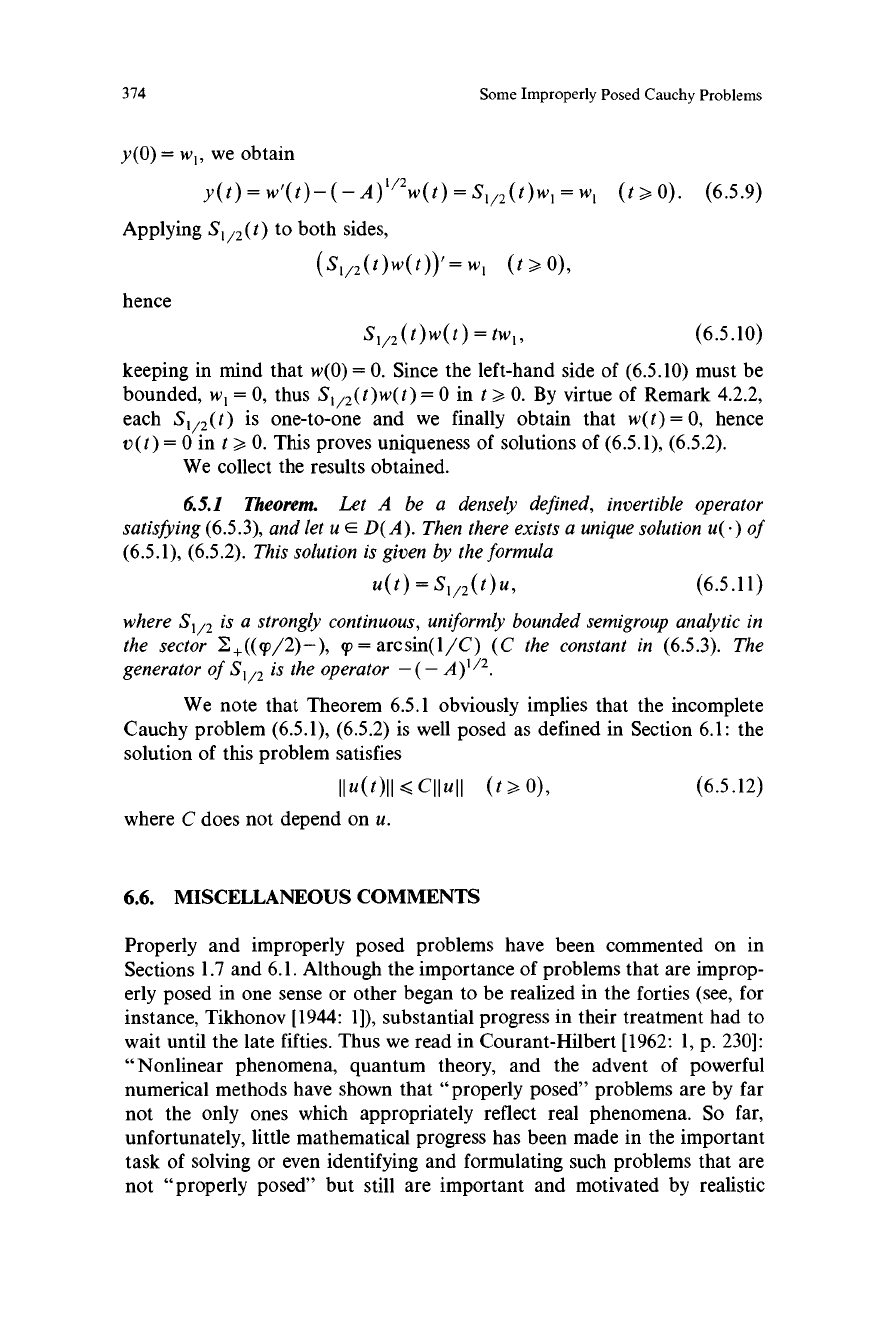
374
Some Improperly Posed Cauchy Problems
y(O) = w,, we obtain
y(t)=w'(t)-(-A)1/2w(t)=S,/2(t)wl=w,
(t>0).
(6.5.9)
Applying Sl/2(t) to both sides,
(Sl/2(t)w(t))'= wl (t >- 0),
hence
S112(t)w(t) = twl,
(6.5.10)
keeping in mind that w(0) = 0. Since the left-hand side of (6.5.10) must be
bounded, w1 = 0, thus S,12(t)W(t) = 0 in t >, 0. By virtue of Remark 4.2.2,
each S112(t) is one-to-one and we finally obtain that w(t) = 0, hence
v(t) = 0 in t >, 0. This proves uniqueness of solutions of (6.5.1), (6.5.2).
We collect the results obtained.
6.5.1
Theorem.
Let A be a densely defined, invertible operator
satisfying (6.5.3), and let u E D(A). Then there exists a unique solution u(.) of
(6.5.1), (6.5.2). This solution is given by the formula
u(t) =S112(t)u,
(6.5.11)
where S1/2 is a strongly continuous, uniformly bounded semigroup analytic in
the sector 2+((p/2)-), V = aresin(1/C) (C the constant in (6.5.3). The
generator of S1/2 is the operator - ( - A)1 /2.
We note that Theorem 6.5.1 obviously implies that the incomplete
Cauchy problem (6.5.1), (6.5.2) is well posed as defined in Section 6.1: the
solution of this problem satisfies
Ilu(t)II CIIuIi
(t,0),
(6.5.12)
where C does not depend on u.
6.6.
MISCELLANEOUS COMMENTS
Properly and improperly posed problems have been commented on in
Sections 1.7 and 6.1. Although the importance of problems that are improp-
erly posed in one sense or other began to be realized in the forties (see, for
instance, Tikhonov [1944: 1]), substantial progress in their treatment had to
wait until the late fifties. Thus we read in Courant-Hilbert [1962: 1, p. 230]:
"Nonlinear phenomena, quantum theory, and the advent of powerful
numerical methods have shown that "properly posed" problems are by far
not the only ones which appropriately reflect real phenomena. So far,
unfortunately, little mathematical progress has been made in the important
task of solving or even identifying and formulating such problems that are
not "properly posed" but still are important and motivated by realistic

6.6. Miscellaneous Comments
375
situations." Since then, a true explosion of research activity has occurred, as
attested by the size of the bibliography in Payne's monograph [1975: 1],
which is almost exclusively devoted to several types of improperly posed
Cauchy problems.
With the possible exception of the reversed Cauchy problem in
Section 6.1, none of the problems and examples in this chapter would
probably be recognized by specialists as improperly posed, but rather as
properly posed problems whose correct formulation is somewhat nonstan-
dard. We refer the reader to Payne [1975: 1] for examples, results and
general information on ill-posed Cauchy problems, and we limit ourselves to
a few comments on the material in this chapter.
(a) Section 6.2. Theorem 6.2.1, as well as the definition of problems
that are properly posed for bounded solutions, are due to Krein and
Prozorovskaya [1960: 1]. The fact that an improperly posed problem may be
"stabilized" by a priori restrictions on its solutions was already realized by
Tikhonov [ 1944: 1]. The reversed Cauchy problem for the heat equation
with a priori bounds on the solutions was considered for the first time by
John [1955: 11 (where the bound takes the form of a nonnegativity condi-
tion). The Cauchy problem for elliptic equations was studied in the same
vein by John [1955: 2], Pucci [1955: 1], [1958: 11, and Lavrentiev [1956: 11,
[1957: 1].
The inequalities leading to Theorem 6.2.1 can be considerably shar-
pened under more precise assumptions on the operator A. For instance, we
have
6.6.1 Example.
Let A be a symmetric operator in a Hilbert space H, u(-)
a solution of
u'(t)=Au(t) (0<t<T).
Then log I I u(t) II is convex in 0 < t < T; in particular,
Ilu(t)II < I1
u(0)II'-11TIIu(T)II`1T
(0 < t <T).
(6.6.1)
To see this assume first that u (t) * 0 in 0 < t < T. Then
(log IIu(t)112)"= 2{II
u(t)11-2(Au(t), u(t)))'
= -411 u(t)II -4(Au(t),
u(t))2+411 u11-2IIAu(t)II2,
which is nonnegative in view of the Schwarz inequality. To show (6.6.1) in
general it suffices to prove that u(t) vanishes identically if u(T) = 0. If this
is not true, we may obtain by translation an interval 0 < t < h, where
u(h) = 0, u(t) * 0 for 0 < t < h, a contradiction in view of (6.6.1) applied in
[0, h'], h'< h.
Similar logarithmic convexity results have been obtained for various
functions V(u(t)) of solutions of various classes of differential equations.
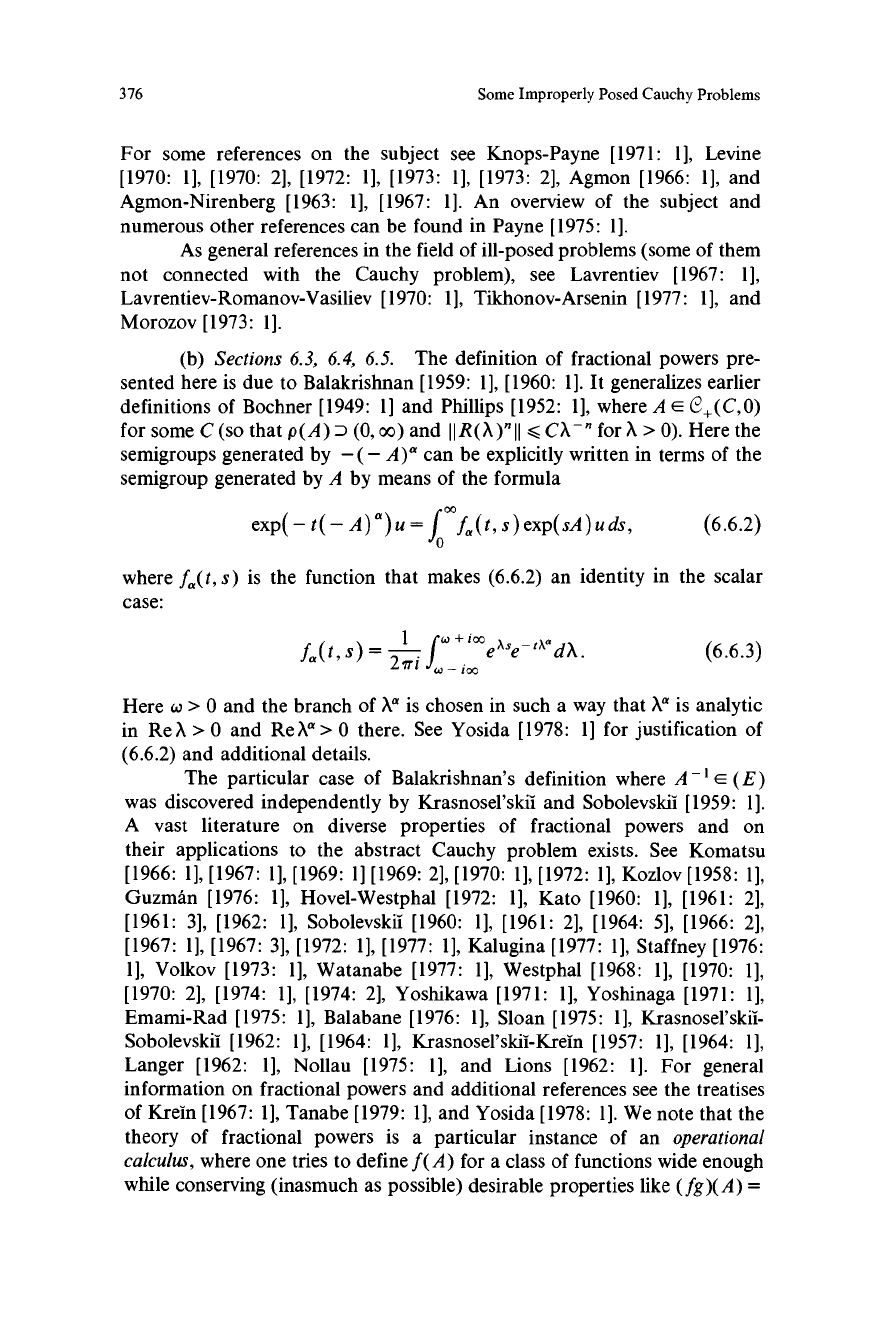
376
Some Improperly Posed Cauchy Problems
For some references on the subject see Knops-Payne [1971: 1], Levine
[1970: 1], [1970: 2], [1972: 1], [1973: 1], [1973: 2], Agmon [1966: 1], and
Agmon-Nirenberg [1963:
11, [1967:
11. An overview of the subject and
numerous other references can be found in Payne [1975: 1].
As general references in the field of ill-posed problems (some of them
not connected with the Cauchy problem), see Lavrentiev [1967:
1],
Lavrentiev-Romanov-Vasiliev [1970:
1], Tikhonov-Arsenin [1977: 1], and
Morozov [1973: 11.
(b) Sections 6.3, 6.4, 6.5.
The definition of fractional powers pre-
sented here is due to Balakrishnan [1959: 1], [1960: 1]. It generalizes earlier
definitions of Bochner [1949: 1] and Phillips [1952: 11, where A E e+(C, 0)
for some C (so that p(A) D (0, oo) and IIR(X)"II < CA-" for A > 0). Here the
semigroups generated by - ( - A)" can be explicitly written in terms of the
semigroup generated by A by means of the formula
exp(-t(-A)")u= f °°f"(t,s)exp(sA)uds, (6.6.2)
where ,,,(t, s) is the function that makes (6.6.2) an identity in the scalar
case:
f"(t, s) =
Iri
fo 0o
wi
e\se-t"dX.
(6.6.3)
2
Here to > 0 and the branch of X" is chosen in such a way that A" is analytic
in Re X > 0 and Re X" > 0 there. See Yosida [ 1978:
1 ] for justification of
(6.6.2) and additional details.
The particular case of Balakrishnan's definition where A` E (E)
was discovered independently by Krasnosel'skii and Sobolevskii [1959: 1].
A vast literature on diverse properties of fractional powers and on
their applications to the abstract Cauchy problem exists. See Komatsu
[ 1966: 1], [1967: 1], [1969: 1] [1969: 2], [1970: 1], [1972: 1], Kozlov [1958: 1],
Guzman [1976:
11, Hovel-Westphal [1972:
11, Kato [1960: 11, [1961: 2],
[1961: 3], [1962: 11, Sobolevskii [1960:
1], [1961: 2], [1964: 5], [1966: 2],
[ 1967: 11, [1967: 3], [1972: 11, [1977: 11, Kalugina [ 1977: 1 ], Staffney [ 1976:
11, Volkov [1973:
1], Watanabe [1977: 11, Westphal [1968:
1], [1970:
1],
[1970: 2], [1974: 1], [1974: 2], Yoshikawa [1971: 1], Yoshinaga [1971: 11,
Emami-Rad [1975: 1], Balabane [1976: 1], Sloan [1975: 1], Krasnosel'skii-
Sobolevskii [1962:
1], [1964: 1), Krasnosel'skii-Krein [1957:
11, [1964:
1],
Langer [1962:
1], Nollau [1975:
1], and Lions [1962: 1]. For general
information on fractional powers and additional references see the treatises
of Krein [ 1967: 1 ], Tanabe [ 1979: 1 ], and Yosida [ 1978: 11. We note that the
theory of fractional powers is a particular instance of an operational
calculus, where one tries to define f(A) for a class of functions wide enough
while conserving (inasmuch as possible) desirable properties like (fg)(A) =
